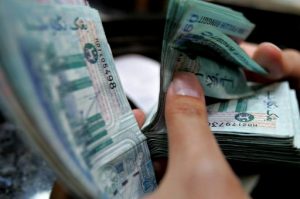(Bernama) – The weakness of the ringgit, mainly attributed to low commodity prices and a slowdown in China’s economy, is temporary, say experts.
Inter-Pacific Research Sdn Bhd Head of Research Pong Teng Siew said Malaysia was dependent on commodities, including crude oil and the sharp decline in prices would eventually have an impact on the government’s revenue, thus pushing investors to take a cautious stance.
Today, the ringgit closed at 4.0375/0415 against the US dollar.
“Initially, the decline in the ringgit was nothing more than on the premise that the United States Federal Reserve was expected to increase interest rates. That move strengthens the US dollar but we become weaker than other currencies.
“Then came the decline in commodity prices, which resulted in more pressure on the local unit,” he said.
As for measures to curb the ringgit slide, Pong said: “Just let it weaken and perhaps the export factor in the economy would benefit from a stronger trade surplus. Over the longer term, some form of equilibrium will be established.”
Oxford Business Group regional editor Paulius Kuncinas said although the domestic political headwinds had somewhat contributed to the decline, the situation was not alarming.
“We are not seeing a full-blown crisis. The domestic situation might result in a slowdown and a little correction, but we should not be too alarmed about that,” he said.
Hence, the current situation is temporary and the ringgit would recover in due course, said Kuncinas.
“It will trade in a range of between 3.80 and 4.20 against the US dollar this year and start recovering in early 2016,” he said.
Meanwhile, a weaker currency was often seen only in the negative perspective amid its knock-on effects on imported components, including food and construction materials, which would translate into higher inflation, said another analyst who requested anonymity.
“But there is often a flip side to it although not broad-based,” he said, adding that in a worst-case scenario, Bank Negara Malaysia could implement policy measures to contain the situation.”
However, he believes that the situation will not go to that extent.
“People are so quick to compare the current decline in the ringgit to that of the 1997/98 financial crisis, but they fail to recognise the difference in the country’s economic fundamentals, which is far better now,” he added.
Recently, Minister in the Prime Minister’s Department Abdul Wahid Omar had said the weakening of the ringgit did not reflect the country’s economic fundamentals.
He said the local banking system was sound and economic activities still intact to drive growth.
“Back in 1997 and 1998 (during the Asian financial crisis), we were hit very badly,” he said, adding that many factors affected Malaysia then, including the trade deficit, reserves falling below US$30 billion and high gearing among companies, some of which were exposed to foreign currency borrowings.
To recap, the country’s gross domestic product (GDP) contracted by 7.4% in 1998 compared with a GDP growth of 4.5% expected this year, while bank lending rates were 13.53% then against 4.57% now.
Malaysia’s foreign reserves in 1998 were only at US$20 billion with trade balance running in deficit.
As at July 31, reserves stood at US$96.7 billion, which were sufficient to finance 7.6 months (1998: 2.6 months) of retained imports and 1.1 times the short-term external debt.
The economy would also benefit from the spillover of the strong infrastructure activities in the region, Kuncinas said.
The Asean Economic Community is an important event this year and advanced economies including the US were looking seriously at Asean for the first time, he added.



No comments:
Post a Comment
Note: Only a member of this blog may post a comment.